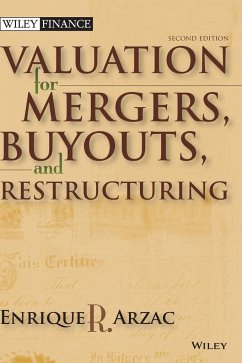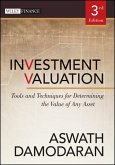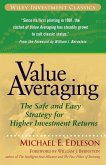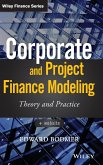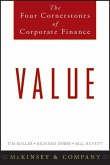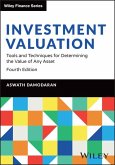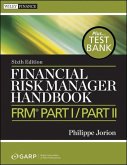- Gebundenes Buch
- Merkliste
- Auf die Merkliste
- Bewerten Bewerten
- Teilen
- Produkt teilen
- Produkterinnerung
- Produkterinnerung
When should you acquire a target or enter a new business? How do you go about structuring and valuing leveraged buyout transactions? What do you do id the application of the weighted average cost of capital approach is not correct?Answers to these commonly encountered valuation problems and more are given right here in this complete valuation toolkit for mergers, buyouts, and restructuring.Enrique Arzac, an internationally recognized authority on the subject, provides an up-to-date, comprehensive synthesis of current valuation theory and practice, including free cash flow valuation, financing…mehr
Andere Kunden interessierten sich auch für
![Investment Valuation Investment Valuation]() Aswath DamodaranInvestment Valuation114,99 €
Aswath DamodaranInvestment Valuation114,99 €![Value Averaging Value Averaging]() Michael E. EdlesonValue Averaging24,99 €
Michael E. EdlesonValue Averaging24,99 €![Corporate and Project Finance Modeling Corporate and Project Finance Modeling]() Edward BodmerCorporate and Project Finance Modeling57,99 €
Edward BodmerCorporate and Project Finance Modeling57,99 €![Value Value]() Tim KollerValue27,99 €
Tim KollerValue27,99 €![Investment Valuation Investment Valuation]() Aswath DamodaranInvestment Valuation143,99 €
Aswath DamodaranInvestment Valuation143,99 €![Financial Risk Manager Handbook, + Test Bank Financial Risk Manager Handbook, + Test Bank]() Philippe JorionFinancial Risk Manager Handbook, + Test Bank173,99 €
Philippe JorionFinancial Risk Manager Handbook, + Test Bank173,99 €![Damodaran on Valuation Damodaran on Valuation]() Aswath DamodaranDamodaran on Valuation83,99 €
Aswath DamodaranDamodaran on Valuation83,99 €-
-
-
When should you acquire a target or enter a new business? How do you go about structuring and valuing leveraged buyout transactions? What do you do id the application of the weighted average cost of capital approach is not correct?Answers to these commonly encountered valuation problems and more are given right here in this complete valuation toolkit for mergers, buyouts, and restructuring.Enrique Arzac, an internationally recognized authority on the subject, provides an up-to-date, comprehensive synthesis of current valuation theory and practice, including free cash flow valuation, financing and valuation of leveraged buyouts, real option analysis for entry and exit decisions, contract design to resolve disagreements about value, and the valuation of special offer structures.Keep up-to-date with the latest thinking on valuation for mergers and acquisitionsEnrique Arzac applies the latest academic thinking to mergers, buyouts, and restructuring, and blends it with his own practical approach to valuation developed over years of consulting.Apply practical valuation procedures to a variety of situationsYou'll learn how to value stand-alone companies and business units, merged firms, foreign firms in developed or emerging markets, troubled-company restructuring, and more.Learn how to use expert analysis toolsThe book provides the essential analysis tools for estimating the cost of capital for public and private companies, performing discounted cash flow valuation, estimating and applying valuation multiples, estimating sustainable debt, and much more.Save time modeling transactions with professional-grade softwareThe CD included with this book contains DealModeler and Valuation Aids software. DealModeler is integrated modeling software for preparing pro-forma financial statements and valuing mergers, acquisitions, and leveraged buyouts, similar to those used by investment bankers and appraisal professionals. Valuation Aids software is designed to help you perform specialized computations, such as estimating the equity premium and valuing financial and real options.
Hinweis: Dieser Artikel kann nur an eine deutsche Lieferadresse ausgeliefert werden.
Hinweis: Dieser Artikel kann nur an eine deutsche Lieferadresse ausgeliefert werden.
Produktdetails
- Produktdetails
- Verlag: Wiley & Sons
- Artikelnr. des Verlages: 14512889000
- 2. Aufl.
- Seitenzahl: 480
- Erscheinungstermin: 21. Dezember 2007
- Englisch
- Abmessung: 260mm x 183mm x 30mm
- Gewicht: 820g
- ISBN-13: 9780470128893
- ISBN-10: 0470128895
- Artikelnr.: 22874628
- Herstellerkennzeichnung
- Libri GmbH
- Europaallee 1
- 36244 Bad Hersfeld
- gpsr@libri.de
- Verlag: Wiley & Sons
- Artikelnr. des Verlages: 14512889000
- 2. Aufl.
- Seitenzahl: 480
- Erscheinungstermin: 21. Dezember 2007
- Englisch
- Abmessung: 260mm x 183mm x 30mm
- Gewicht: 820g
- ISBN-13: 9780470128893
- ISBN-10: 0470128895
- Artikelnr.: 22874628
- Herstellerkennzeichnung
- Libri GmbH
- Europaallee 1
- 36244 Bad Hersfeld
- gpsr@libri.de
Enrique R. Arzac is Professor of Finance and Economics at the Columbia University Graduate School of Business, Director of the Merger, Buyouts, and Restructuring program for executives at Columbia Business School, and Co-Director of the Merger and Acquisitions program for executives at London Business School. He is the author of many academic articles in financial economics and has been consultant to corporations and financial institutions in North and South America and Europe. He is a director of the Adams Express Company, Petroleum and Resources Corporation and Credit Suisse Asset Management funds.
Part One: The Tools of Valuation.
1. A User's Guide.
1.1. Valuation of Stand-Alone Firms and Business Units.
1.1.1 Free Cash-flow Valuation.
1.1.2 Cost of Capital.
1.1.3 Valuation Multiples.
1.2. Economic Value Added.
1.3. Valuation with Changing Capital Structure.
1.4. Valuation in Developed and Emerging Markets.
1.5. Mergers and Acquisitions.
1.6. Deal Design and Special Offer Structures.
1.7. Leveraged Buyouts.
1.8. Recapitalization of Troubled Companies.
1.9. Asset Restructuring.
1.10. Real Options: Valuing Entry and Exit Options.
1.10.1 Financial Options.
1.11. Technical Notes and Problems.
1.12. Valuation Aids and DealModeler® Software.
2. Forecasting and Valuation of Free Cash Flows.
2.1. Free Cash Flows.
2.2. Building a Financial Model.
2.3. Enterprise Valuation.
2.4. Continuation Value.
2.4.1 Forecast Consistency.
2.4.2 Forecasting FCFT.
2.4.3 A Wrong Way to Forecast Continuation Value.
2.4.4 Sensitivity to Parameter Estimates.
2.4.5 Competitive Advantage Period.
2.4.6 EBITDA Multiples.
2.5. An Equivalent Approach: Valuing the Cash Flow to Equity.
2.5.1 Decomposition of Free Cash Flows: Cash Flows to Equity and Debt.
2.5.2 Equity Valuation.
2.5.3 Debt Valuation.
2.5.4 Financial Policy and Dividends.
2.6. Some Practical Aspects.
2.6.1 Choosing the Valuation Method.
2.6.2 Personal Taxes and Enterprise Value.
2.6.3 Enterprise Value in Tax-imputation Countries.
2.6.4 Balance Sheet Adjustments.
2.6.5 Cash and Marketable Securities.
2.6.6 Mid-year Discounting.
2.6.7 Dealing with Equity-linked and Other Securities in the Capital
Structure.
2.6.8 Restructuring Expenses.
2.7. Analysis of Results: The Value of Franchise and Growth.
2.8 Summary.
Problems.
3. The Equity Premium and the Cost of Capital.
3.1. Estimating the Cost of Capital.
3.2. The Cost of Equity.
3.2.1 The Capital Asset Pricing Model Approach.
3.2.2 Choosing the Riskless Rate.
3.2.3 Estimating the Equity Premium: Historical Analyses.
3.2.4 Time Varying Equity Premium.
3.2.5 Prospective Equity Premium.
3.3. The Cost of Equity of Large Capitalization Companies.
3.4. The Cost of Equity and Leverage.
3.5. Beyond the Capital Asset Pricing Model.
3.5.1 The Original CAPM.
3.5.2 The Fama-French Three-factor Model.
3.5.3 Arbitrage Pricing Theory.
3.5.4 Liquidity and Expected Returns.
3.6. The Cost of Equity of Small Capitalization Companies.
3.7. Estimating the Cost of Equity: A Detailed Example.
3.8. The Cost of Debt and Other Components of the Capital Structure.
3.8.1 Investment-grade Debt.
3.8.2 High-yield Debt and Preferred Stock.
3.8.3 Convertible Securities, Warrants, and Other Options.
3.9. Estimation of the Cost of Capital in Practice.
3.10. Summary.
Problems.
4. Metrics and Multiples.
4.1. The Use of Multiples in Valuation.
4.2. Using Comparables: An Example.
4.3. Multiples and Continuation Value.
4.4. Relationships Among Valuation Multiples.
4.5. Adjusting Multiples for Leverage and Growth.
4.6. The Franchise Factor in Valuation Multiples.
4.7. Normalizing P/E Ratios by the Growth Rate.
4.8. Summary.
Problems.
5. Economic Value Added.
5.1. Measuring Value Creation.
5.2. Relation to Free Cash-Flow Valuation.
5.3. A Detailed Example of EVA Valuation.
5.4. The Sources of Value: Franchise and Growth.
5.5. Economic Value-Added and Market Value.
5.6. Some Empirical Evidence.
5.7. Summary.
Problems.
6. Valuation with Changing Capital Structure.
6.1. Leverage Changes and Enterprise Value.
6.2. Adjusted Present Value and The Value of the Tax Shield.
6.3. A Detailed Example of APV Valuation.
6.4. Valuing an Acquisition with Leverage Above Target.
6.5. Recursive WACC Valuation.
6.6. Compressed APV.
6.7. Uncertain Leverage: A Recursive APV Model.
6.8. Valuing Equity as an Option.
6.9. Summary.
Problems.
7. Debt Capacity for Acquisition Financing.
7.1. Financial Interdependencies.
7.2. Financing Growth.
7.3. Growth via Acquisitions.
7.4. Sustainable Debt.
7.5. The Target Debt Ratio Assumed in WACC Valuation, Debt Capacity, and
Interest Coverage.
7.6. Debt Capacity in Leveraged Buyouts and Recapitalizations.
7.7. The Debt Capacity Multiple in Practice.
7.8. Summary.
Problems.
8. Valuing Entry and Exit Options.
8.1. Net Present Value and Options.
8.1.1 Accounting for Flexibility.
8.1.2 Option Pricing.
8.2. A Continuous-Time Model of Free Cash Flows.
8.3. Valuation in Discrete and Continuous Times.
8.4. Valuing a Going Concern in Continuous Time.
8.5. Valuing the Entry Option.
8.6. Entry and Exit Options.
8.7. Valuing Foothold and Growth Options.
8.7.1 Foothold Investment with an Expansion Option.
8.7.2 Valuing Foothold and Expansion Options.
8.8. Allowing for Uncertain Costs in Foothold Investments.
8.9. Sensitivity of DCF Values in the Presence of Real Options.
8.10. Summary.
Problems.
Part Two: Mergers, Acquisitions, and Buyouts.
9. Mergers and Acquisitions.
9.1. Value Creation and Mergers.
9.2. Legal Form of the Transaction and Tax Considerations.
9.3. Examples of Tax Consequences.
9.4. Tax-Free Reorganizations.
9.5. Merger Accounting.
9.6. Premiums and the Iron Law of M&A.
9.6.1 All-cash Offer.
9.6.2 Share Exchange.
9.6.3 Cash and Share Offer.
9.7. Break-Even Synergies.
9.8. Premiums and the Acquirer's Foothold.
9.9. Accretion-Dilution Analysis.
9.10. Free Cash-Flow Valuation: Total Versus Incremental Free Cash Flows.
9.11. Comprehensive Merger Example.
9.11.1 Terms of the Merger.
9.11.2 Building the Financial Model of the Merger.
9.11.3 Accretion-dilution Analysis.
9.11.4 Free Cash-flow Valuation.
9.11.5 Sensitivity and Scenario Analysis.
9.12. Summary.
Problems.
10. Deal Making with Difference of Opinion.
10.1. Sources of Disagreement in Deal Making.
10.2. Risk Shifting.
10.3. Staged Financing.
10.4. Earnout Agreements.
10.5. Valuing Earnout Cash Flows.
10.6. Earnouts as Options on Future Cash Flows.
10.6.1 Earnouts with Thresholds.
10.6.2 Earnouts with Thresholds and Caps.
10.6.3 Earnouts Based on Average Performance.
10.6.4 Valuing the Seller's Repurchase Option.
10.6.5 Valuing Multiyear Earnouts.
10.6.6 Earnouts Based upon Relative Performance.
10.7. Perpetual Earnouts and Class Shares with Threshold.
10.8 Summary.
Problems.
11. Special Offer Structures: Price Guarantees and Collars.
11.1 Special Offer Structures.
11.1.1 Risk Arbitrage.
11.1.2 Guarantees.
11.2. Valuing Price Guarantees.
11.2.1 Commodity Price Guarantees.
11.3. Valuing Offers with Price Collars.
11.4. Additional Features in Price Collars.
11.4.1 Walk-away Rights.
11.4.2 Top-up Rights.
11.4.3 Fixed Exchange Ratio with Collar.
11.4.4 Weighted Average.
11.5 Summary.
Problems.
12. Acquisitions in Developed and Emerging Markets.
12.1. The Global Capital Market.
12.2. Translating Foreign Currency Cash Flows.
12.3. The Cost of Capital in Developed Capital Markets.
12.4. Valuing Emerging-Market Companies.
12.4.1 Translating Free Cash Flows to the Acquirer's Currency.
12.4.2 Value to the Acquirer.
12.4.3 Nominal and Real Cash Flows and the Cost of Capital.
12.4.4 Value to the Seller.
12.5. On the Nature of the Country Risk Premium.
12.6. Post-Emergence Systematic Risk.
12.7. Summary.
Problems.
13. Leveraged Buyouts.
13.1. The Rationale for LBOs.
13.2. Financing LBOs.
13.3. Robust Financial Structures.
13.4. Computing the Returns to Investors.
13.5. Option Pricing of Warrant Kickers.
13.6. Debt Capacity and Affordable Price.
13.7. Returns to Investors and the Private-Equity Discount.
13.8. A Detailed LBO Example.
13.9. Mezzanine Financing.
13.10. APV Valuation.
13.11. Summary.
Problems.
Part Three: Recapitalizations and Restructuring.
14. Recapitalization of Troubled Companies.
14.1. Dealing with Financial Distress.
14.2. Framework for Recapitalizations.
14.3. Out-Of-Court Workouts and Bankruptcy.
14.3.1 Out-of-court Workouts.
14.3.2 In-court Reorganization.
14.3.3 Prepackaged Bankruptcy.
14.3.4 Liquidation.
14.4. Accounting Treatment.
14.4.1 Troubled Debt Restructuring.
14.4.2 Asset Impairment.
14.4.3 Fresh-start Accounting.
14.5. Tax Considerations.
14.6. Valuing Recapitalization Securities.
14.6.1 The Southland LBO.
14.6.2 The Recapitalization Plans.
14.6.3 Valuing the New Debt Securities.
14.6.4 Valuing Equity.
14.6.5 Recovery.
14.7. Valuing Recapitalization Rights and Options.
14.8. Summary.
Problems.
15. Asset Restructuring.
15.1. Asset Restructuring and the Value Gap.
15.2. Is There a Diversification Discount?
15.3. Share Repurchases.
15.4. Asset Disposition.
15.5. Tax and Accounting Treatment.
15.5.1 Private Sales, IPOs, and Carve-outs.
15.5.2 Spin-offs.
15.5.3 Tracking Stock.
15.6. Sum-of-the-Parts Valuation.
15.7. Headquarter Costs and Benefits.
15.8 Comprehensive Restructuring Analysis.
15.8.1 Sum-of-the-Parts Valuation: Multiples.
15.8.2 Sum-of-the-Parts Valuation: Free Cash Flows.
15.8.3 Valuing the Effect of Cost Reductions at Wendy's Stores.
15.8.4 Refranchising Wendy's Operated Restaurants.
15.8.5 Comparison of Restructuring Actions.
15.8.6 Monetizing Real Estate.
15.8.7 Share Repurchases.
15.8.8 Wendy's Restructuring Plan.
15.9. Summary.
Problems.
Appendix A. Financial Options.
A.1 Financial Options in M & A Valuation.
A.2 European Calls and Puts and American Calls.
A.3 American Puts.
A.4 Warrant Pricing Model.
A.5 Asian Options.
A.6 Knockout (Barrier) Options.
A.7 The Put-Call Parity.
A.8 Stock Options Paying A Known Dividend Yield.
A.9 Dilution Adjustment in Warrant Valuation.
Problems.
Appendix B. Valuation Aids Software.
Appendix C. Answers to Selected End-of-Chapter Problems.
Appendix D. Modeling Mergers and Buyouts with DealModeler(TM): User's
Manual.
D.1 Brief Description of DealModeler.
D.1.1 Financial Modeling.
D.1.2 Inputs.
D.1.3 Addictions.
D.1.4 Printing Output.
D.1.5 Demo and Blank Copies.
D.2 Modeling Mergers and Acquisitions.
D.2.1 Setting Up the Financial Model for M&A Transactions.
D.2.2 Valuation.
D.2.3 Checking the Model.
D.2.4 Printing M&A Financials and Valuation Output.
D.2.5 Sensitivity and Scenario Analysis.
D.3 Modeling Leveraged Buyouts.
D.3.1 Setting Up the Financial Model for LBO Transactions.
D.3.2 IRR Valuation.
D.3.3 Checking the Model and Printing.
Technical Notes.
References.
Index.
1. A User's Guide.
1.1. Valuation of Stand-Alone Firms and Business Units.
1.1.1 Free Cash-flow Valuation.
1.1.2 Cost of Capital.
1.1.3 Valuation Multiples.
1.2. Economic Value Added.
1.3. Valuation with Changing Capital Structure.
1.4. Valuation in Developed and Emerging Markets.
1.5. Mergers and Acquisitions.
1.6. Deal Design and Special Offer Structures.
1.7. Leveraged Buyouts.
1.8. Recapitalization of Troubled Companies.
1.9. Asset Restructuring.
1.10. Real Options: Valuing Entry and Exit Options.
1.10.1 Financial Options.
1.11. Technical Notes and Problems.
1.12. Valuation Aids and DealModeler® Software.
2. Forecasting and Valuation of Free Cash Flows.
2.1. Free Cash Flows.
2.2. Building a Financial Model.
2.3. Enterprise Valuation.
2.4. Continuation Value.
2.4.1 Forecast Consistency.
2.4.2 Forecasting FCFT.
2.4.3 A Wrong Way to Forecast Continuation Value.
2.4.4 Sensitivity to Parameter Estimates.
2.4.5 Competitive Advantage Period.
2.4.6 EBITDA Multiples.
2.5. An Equivalent Approach: Valuing the Cash Flow to Equity.
2.5.1 Decomposition of Free Cash Flows: Cash Flows to Equity and Debt.
2.5.2 Equity Valuation.
2.5.3 Debt Valuation.
2.5.4 Financial Policy and Dividends.
2.6. Some Practical Aspects.
2.6.1 Choosing the Valuation Method.
2.6.2 Personal Taxes and Enterprise Value.
2.6.3 Enterprise Value in Tax-imputation Countries.
2.6.4 Balance Sheet Adjustments.
2.6.5 Cash and Marketable Securities.
2.6.6 Mid-year Discounting.
2.6.7 Dealing with Equity-linked and Other Securities in the Capital
Structure.
2.6.8 Restructuring Expenses.
2.7. Analysis of Results: The Value of Franchise and Growth.
2.8 Summary.
Problems.
3. The Equity Premium and the Cost of Capital.
3.1. Estimating the Cost of Capital.
3.2. The Cost of Equity.
3.2.1 The Capital Asset Pricing Model Approach.
3.2.2 Choosing the Riskless Rate.
3.2.3 Estimating the Equity Premium: Historical Analyses.
3.2.4 Time Varying Equity Premium.
3.2.5 Prospective Equity Premium.
3.3. The Cost of Equity of Large Capitalization Companies.
3.4. The Cost of Equity and Leverage.
3.5. Beyond the Capital Asset Pricing Model.
3.5.1 The Original CAPM.
3.5.2 The Fama-French Three-factor Model.
3.5.3 Arbitrage Pricing Theory.
3.5.4 Liquidity and Expected Returns.
3.6. The Cost of Equity of Small Capitalization Companies.
3.7. Estimating the Cost of Equity: A Detailed Example.
3.8. The Cost of Debt and Other Components of the Capital Structure.
3.8.1 Investment-grade Debt.
3.8.2 High-yield Debt and Preferred Stock.
3.8.3 Convertible Securities, Warrants, and Other Options.
3.9. Estimation of the Cost of Capital in Practice.
3.10. Summary.
Problems.
4. Metrics and Multiples.
4.1. The Use of Multiples in Valuation.
4.2. Using Comparables: An Example.
4.3. Multiples and Continuation Value.
4.4. Relationships Among Valuation Multiples.
4.5. Adjusting Multiples for Leverage and Growth.
4.6. The Franchise Factor in Valuation Multiples.
4.7. Normalizing P/E Ratios by the Growth Rate.
4.8. Summary.
Problems.
5. Economic Value Added.
5.1. Measuring Value Creation.
5.2. Relation to Free Cash-Flow Valuation.
5.3. A Detailed Example of EVA Valuation.
5.4. The Sources of Value: Franchise and Growth.
5.5. Economic Value-Added and Market Value.
5.6. Some Empirical Evidence.
5.7. Summary.
Problems.
6. Valuation with Changing Capital Structure.
6.1. Leverage Changes and Enterprise Value.
6.2. Adjusted Present Value and The Value of the Tax Shield.
6.3. A Detailed Example of APV Valuation.
6.4. Valuing an Acquisition with Leverage Above Target.
6.5. Recursive WACC Valuation.
6.6. Compressed APV.
6.7. Uncertain Leverage: A Recursive APV Model.
6.8. Valuing Equity as an Option.
6.9. Summary.
Problems.
7. Debt Capacity for Acquisition Financing.
7.1. Financial Interdependencies.
7.2. Financing Growth.
7.3. Growth via Acquisitions.
7.4. Sustainable Debt.
7.5. The Target Debt Ratio Assumed in WACC Valuation, Debt Capacity, and
Interest Coverage.
7.6. Debt Capacity in Leveraged Buyouts and Recapitalizations.
7.7. The Debt Capacity Multiple in Practice.
7.8. Summary.
Problems.
8. Valuing Entry and Exit Options.
8.1. Net Present Value and Options.
8.1.1 Accounting for Flexibility.
8.1.2 Option Pricing.
8.2. A Continuous-Time Model of Free Cash Flows.
8.3. Valuation in Discrete and Continuous Times.
8.4. Valuing a Going Concern in Continuous Time.
8.5. Valuing the Entry Option.
8.6. Entry and Exit Options.
8.7. Valuing Foothold and Growth Options.
8.7.1 Foothold Investment with an Expansion Option.
8.7.2 Valuing Foothold and Expansion Options.
8.8. Allowing for Uncertain Costs in Foothold Investments.
8.9. Sensitivity of DCF Values in the Presence of Real Options.
8.10. Summary.
Problems.
Part Two: Mergers, Acquisitions, and Buyouts.
9. Mergers and Acquisitions.
9.1. Value Creation and Mergers.
9.2. Legal Form of the Transaction and Tax Considerations.
9.3. Examples of Tax Consequences.
9.4. Tax-Free Reorganizations.
9.5. Merger Accounting.
9.6. Premiums and the Iron Law of M&A.
9.6.1 All-cash Offer.
9.6.2 Share Exchange.
9.6.3 Cash and Share Offer.
9.7. Break-Even Synergies.
9.8. Premiums and the Acquirer's Foothold.
9.9. Accretion-Dilution Analysis.
9.10. Free Cash-Flow Valuation: Total Versus Incremental Free Cash Flows.
9.11. Comprehensive Merger Example.
9.11.1 Terms of the Merger.
9.11.2 Building the Financial Model of the Merger.
9.11.3 Accretion-dilution Analysis.
9.11.4 Free Cash-flow Valuation.
9.11.5 Sensitivity and Scenario Analysis.
9.12. Summary.
Problems.
10. Deal Making with Difference of Opinion.
10.1. Sources of Disagreement in Deal Making.
10.2. Risk Shifting.
10.3. Staged Financing.
10.4. Earnout Agreements.
10.5. Valuing Earnout Cash Flows.
10.6. Earnouts as Options on Future Cash Flows.
10.6.1 Earnouts with Thresholds.
10.6.2 Earnouts with Thresholds and Caps.
10.6.3 Earnouts Based on Average Performance.
10.6.4 Valuing the Seller's Repurchase Option.
10.6.5 Valuing Multiyear Earnouts.
10.6.6 Earnouts Based upon Relative Performance.
10.7. Perpetual Earnouts and Class Shares with Threshold.
10.8 Summary.
Problems.
11. Special Offer Structures: Price Guarantees and Collars.
11.1 Special Offer Structures.
11.1.1 Risk Arbitrage.
11.1.2 Guarantees.
11.2. Valuing Price Guarantees.
11.2.1 Commodity Price Guarantees.
11.3. Valuing Offers with Price Collars.
11.4. Additional Features in Price Collars.
11.4.1 Walk-away Rights.
11.4.2 Top-up Rights.
11.4.3 Fixed Exchange Ratio with Collar.
11.4.4 Weighted Average.
11.5 Summary.
Problems.
12. Acquisitions in Developed and Emerging Markets.
12.1. The Global Capital Market.
12.2. Translating Foreign Currency Cash Flows.
12.3. The Cost of Capital in Developed Capital Markets.
12.4. Valuing Emerging-Market Companies.
12.4.1 Translating Free Cash Flows to the Acquirer's Currency.
12.4.2 Value to the Acquirer.
12.4.3 Nominal and Real Cash Flows and the Cost of Capital.
12.4.4 Value to the Seller.
12.5. On the Nature of the Country Risk Premium.
12.6. Post-Emergence Systematic Risk.
12.7. Summary.
Problems.
13. Leveraged Buyouts.
13.1. The Rationale for LBOs.
13.2. Financing LBOs.
13.3. Robust Financial Structures.
13.4. Computing the Returns to Investors.
13.5. Option Pricing of Warrant Kickers.
13.6. Debt Capacity and Affordable Price.
13.7. Returns to Investors and the Private-Equity Discount.
13.8. A Detailed LBO Example.
13.9. Mezzanine Financing.
13.10. APV Valuation.
13.11. Summary.
Problems.
Part Three: Recapitalizations and Restructuring.
14. Recapitalization of Troubled Companies.
14.1. Dealing with Financial Distress.
14.2. Framework for Recapitalizations.
14.3. Out-Of-Court Workouts and Bankruptcy.
14.3.1 Out-of-court Workouts.
14.3.2 In-court Reorganization.
14.3.3 Prepackaged Bankruptcy.
14.3.4 Liquidation.
14.4. Accounting Treatment.
14.4.1 Troubled Debt Restructuring.
14.4.2 Asset Impairment.
14.4.3 Fresh-start Accounting.
14.5. Tax Considerations.
14.6. Valuing Recapitalization Securities.
14.6.1 The Southland LBO.
14.6.2 The Recapitalization Plans.
14.6.3 Valuing the New Debt Securities.
14.6.4 Valuing Equity.
14.6.5 Recovery.
14.7. Valuing Recapitalization Rights and Options.
14.8. Summary.
Problems.
15. Asset Restructuring.
15.1. Asset Restructuring and the Value Gap.
15.2. Is There a Diversification Discount?
15.3. Share Repurchases.
15.4. Asset Disposition.
15.5. Tax and Accounting Treatment.
15.5.1 Private Sales, IPOs, and Carve-outs.
15.5.2 Spin-offs.
15.5.3 Tracking Stock.
15.6. Sum-of-the-Parts Valuation.
15.7. Headquarter Costs and Benefits.
15.8 Comprehensive Restructuring Analysis.
15.8.1 Sum-of-the-Parts Valuation: Multiples.
15.8.2 Sum-of-the-Parts Valuation: Free Cash Flows.
15.8.3 Valuing the Effect of Cost Reductions at Wendy's Stores.
15.8.4 Refranchising Wendy's Operated Restaurants.
15.8.5 Comparison of Restructuring Actions.
15.8.6 Monetizing Real Estate.
15.8.7 Share Repurchases.
15.8.8 Wendy's Restructuring Plan.
15.9. Summary.
Problems.
Appendix A. Financial Options.
A.1 Financial Options in M & A Valuation.
A.2 European Calls and Puts and American Calls.
A.3 American Puts.
A.4 Warrant Pricing Model.
A.5 Asian Options.
A.6 Knockout (Barrier) Options.
A.7 The Put-Call Parity.
A.8 Stock Options Paying A Known Dividend Yield.
A.9 Dilution Adjustment in Warrant Valuation.
Problems.
Appendix B. Valuation Aids Software.
Appendix C. Answers to Selected End-of-Chapter Problems.
Appendix D. Modeling Mergers and Buyouts with DealModeler(TM): User's
Manual.
D.1 Brief Description of DealModeler.
D.1.1 Financial Modeling.
D.1.2 Inputs.
D.1.3 Addictions.
D.1.4 Printing Output.
D.1.5 Demo and Blank Copies.
D.2 Modeling Mergers and Acquisitions.
D.2.1 Setting Up the Financial Model for M&A Transactions.
D.2.2 Valuation.
D.2.3 Checking the Model.
D.2.4 Printing M&A Financials and Valuation Output.
D.2.5 Sensitivity and Scenario Analysis.
D.3 Modeling Leveraged Buyouts.
D.3.1 Setting Up the Financial Model for LBO Transactions.
D.3.2 IRR Valuation.
D.3.3 Checking the Model and Printing.
Technical Notes.
References.
Index.
Part One: The Tools of Valuation.
1. A User's Guide.
1.1. Valuation of Stand-Alone Firms and Business Units.
1.1.1 Free Cash-flow Valuation.
1.1.2 Cost of Capital.
1.1.3 Valuation Multiples.
1.2. Economic Value Added.
1.3. Valuation with Changing Capital Structure.
1.4. Valuation in Developed and Emerging Markets.
1.5. Mergers and Acquisitions.
1.6. Deal Design and Special Offer Structures.
1.7. Leveraged Buyouts.
1.8. Recapitalization of Troubled Companies.
1.9. Asset Restructuring.
1.10. Real Options: Valuing Entry and Exit Options.
1.10.1 Financial Options.
1.11. Technical Notes and Problems.
1.12. Valuation Aids and DealModeler® Software.
2. Forecasting and Valuation of Free Cash Flows.
2.1. Free Cash Flows.
2.2. Building a Financial Model.
2.3. Enterprise Valuation.
2.4. Continuation Value.
2.4.1 Forecast Consistency.
2.4.2 Forecasting FCFT.
2.4.3 A Wrong Way to Forecast Continuation Value.
2.4.4 Sensitivity to Parameter Estimates.
2.4.5 Competitive Advantage Period.
2.4.6 EBITDA Multiples.
2.5. An Equivalent Approach: Valuing the Cash Flow to Equity.
2.5.1 Decomposition of Free Cash Flows: Cash Flows to Equity and Debt.
2.5.2 Equity Valuation.
2.5.3 Debt Valuation.
2.5.4 Financial Policy and Dividends.
2.6. Some Practical Aspects.
2.6.1 Choosing the Valuation Method.
2.6.2 Personal Taxes and Enterprise Value.
2.6.3 Enterprise Value in Tax-imputation Countries.
2.6.4 Balance Sheet Adjustments.
2.6.5 Cash and Marketable Securities.
2.6.6 Mid-year Discounting.
2.6.7 Dealing with Equity-linked and Other Securities in the Capital
Structure.
2.6.8 Restructuring Expenses.
2.7. Analysis of Results: The Value of Franchise and Growth.
2.8 Summary.
Problems.
3. The Equity Premium and the Cost of Capital.
3.1. Estimating the Cost of Capital.
3.2. The Cost of Equity.
3.2.1 The Capital Asset Pricing Model Approach.
3.2.2 Choosing the Riskless Rate.
3.2.3 Estimating the Equity Premium: Historical Analyses.
3.2.4 Time Varying Equity Premium.
3.2.5 Prospective Equity Premium.
3.3. The Cost of Equity of Large Capitalization Companies.
3.4. The Cost of Equity and Leverage.
3.5. Beyond the Capital Asset Pricing Model.
3.5.1 The Original CAPM.
3.5.2 The Fama-French Three-factor Model.
3.5.3 Arbitrage Pricing Theory.
3.5.4 Liquidity and Expected Returns.
3.6. The Cost of Equity of Small Capitalization Companies.
3.7. Estimating the Cost of Equity: A Detailed Example.
3.8. The Cost of Debt and Other Components of the Capital Structure.
3.8.1 Investment-grade Debt.
3.8.2 High-yield Debt and Preferred Stock.
3.8.3 Convertible Securities, Warrants, and Other Options.
3.9. Estimation of the Cost of Capital in Practice.
3.10. Summary.
Problems.
4. Metrics and Multiples.
4.1. The Use of Multiples in Valuation.
4.2. Using Comparables: An Example.
4.3. Multiples and Continuation Value.
4.4. Relationships Among Valuation Multiples.
4.5. Adjusting Multiples for Leverage and Growth.
4.6. The Franchise Factor in Valuation Multiples.
4.7. Normalizing P/E Ratios by the Growth Rate.
4.8. Summary.
Problems.
5. Economic Value Added.
5.1. Measuring Value Creation.
5.2. Relation to Free Cash-Flow Valuation.
5.3. A Detailed Example of EVA Valuation.
5.4. The Sources of Value: Franchise and Growth.
5.5. Economic Value-Added and Market Value.
5.6. Some Empirical Evidence.
5.7. Summary.
Problems.
6. Valuation with Changing Capital Structure.
6.1. Leverage Changes and Enterprise Value.
6.2. Adjusted Present Value and The Value of the Tax Shield.
6.3. A Detailed Example of APV Valuation.
6.4. Valuing an Acquisition with Leverage Above Target.
6.5. Recursive WACC Valuation.
6.6. Compressed APV.
6.7. Uncertain Leverage: A Recursive APV Model.
6.8. Valuing Equity as an Option.
6.9. Summary.
Problems.
7. Debt Capacity for Acquisition Financing.
7.1. Financial Interdependencies.
7.2. Financing Growth.
7.3. Growth via Acquisitions.
7.4. Sustainable Debt.
7.5. The Target Debt Ratio Assumed in WACC Valuation, Debt Capacity, and
Interest Coverage.
7.6. Debt Capacity in Leveraged Buyouts and Recapitalizations.
7.7. The Debt Capacity Multiple in Practice.
7.8. Summary.
Problems.
8. Valuing Entry and Exit Options.
8.1. Net Present Value and Options.
8.1.1 Accounting for Flexibility.
8.1.2 Option Pricing.
8.2. A Continuous-Time Model of Free Cash Flows.
8.3. Valuation in Discrete and Continuous Times.
8.4. Valuing a Going Concern in Continuous Time.
8.5. Valuing the Entry Option.
8.6. Entry and Exit Options.
8.7. Valuing Foothold and Growth Options.
8.7.1 Foothold Investment with an Expansion Option.
8.7.2 Valuing Foothold and Expansion Options.
8.8. Allowing for Uncertain Costs in Foothold Investments.
8.9. Sensitivity of DCF Values in the Presence of Real Options.
8.10. Summary.
Problems.
Part Two: Mergers, Acquisitions, and Buyouts.
9. Mergers and Acquisitions.
9.1. Value Creation and Mergers.
9.2. Legal Form of the Transaction and Tax Considerations.
9.3. Examples of Tax Consequences.
9.4. Tax-Free Reorganizations.
9.5. Merger Accounting.
9.6. Premiums and the Iron Law of M&A.
9.6.1 All-cash Offer.
9.6.2 Share Exchange.
9.6.3 Cash and Share Offer.
9.7. Break-Even Synergies.
9.8. Premiums and the Acquirer's Foothold.
9.9. Accretion-Dilution Analysis.
9.10. Free Cash-Flow Valuation: Total Versus Incremental Free Cash Flows.
9.11. Comprehensive Merger Example.
9.11.1 Terms of the Merger.
9.11.2 Building the Financial Model of the Merger.
9.11.3 Accretion-dilution Analysis.
9.11.4 Free Cash-flow Valuation.
9.11.5 Sensitivity and Scenario Analysis.
9.12. Summary.
Problems.
10. Deal Making with Difference of Opinion.
10.1. Sources of Disagreement in Deal Making.
10.2. Risk Shifting.
10.3. Staged Financing.
10.4. Earnout Agreements.
10.5. Valuing Earnout Cash Flows.
10.6. Earnouts as Options on Future Cash Flows.
10.6.1 Earnouts with Thresholds.
10.6.2 Earnouts with Thresholds and Caps.
10.6.3 Earnouts Based on Average Performance.
10.6.4 Valuing the Seller's Repurchase Option.
10.6.5 Valuing Multiyear Earnouts.
10.6.6 Earnouts Based upon Relative Performance.
10.7. Perpetual Earnouts and Class Shares with Threshold.
10.8 Summary.
Problems.
11. Special Offer Structures: Price Guarantees and Collars.
11.1 Special Offer Structures.
11.1.1 Risk Arbitrage.
11.1.2 Guarantees.
11.2. Valuing Price Guarantees.
11.2.1 Commodity Price Guarantees.
11.3. Valuing Offers with Price Collars.
11.4. Additional Features in Price Collars.
11.4.1 Walk-away Rights.
11.4.2 Top-up Rights.
11.4.3 Fixed Exchange Ratio with Collar.
11.4.4 Weighted Average.
11.5 Summary.
Problems.
12. Acquisitions in Developed and Emerging Markets.
12.1. The Global Capital Market.
12.2. Translating Foreign Currency Cash Flows.
12.3. The Cost of Capital in Developed Capital Markets.
12.4. Valuing Emerging-Market Companies.
12.4.1 Translating Free Cash Flows to the Acquirer's Currency.
12.4.2 Value to the Acquirer.
12.4.3 Nominal and Real Cash Flows and the Cost of Capital.
12.4.4 Value to the Seller.
12.5. On the Nature of the Country Risk Premium.
12.6. Post-Emergence Systematic Risk.
12.7. Summary.
Problems.
13. Leveraged Buyouts.
13.1. The Rationale for LBOs.
13.2. Financing LBOs.
13.3. Robust Financial Structures.
13.4. Computing the Returns to Investors.
13.5. Option Pricing of Warrant Kickers.
13.6. Debt Capacity and Affordable Price.
13.7. Returns to Investors and the Private-Equity Discount.
13.8. A Detailed LBO Example.
13.9. Mezzanine Financing.
13.10. APV Valuation.
13.11. Summary.
Problems.
Part Three: Recapitalizations and Restructuring.
14. Recapitalization of Troubled Companies.
14.1. Dealing with Financial Distress.
14.2. Framework for Recapitalizations.
14.3. Out-Of-Court Workouts and Bankruptcy.
14.3.1 Out-of-court Workouts.
14.3.2 In-court Reorganization.
14.3.3 Prepackaged Bankruptcy.
14.3.4 Liquidation.
14.4. Accounting Treatment.
14.4.1 Troubled Debt Restructuring.
14.4.2 Asset Impairment.
14.4.3 Fresh-start Accounting.
14.5. Tax Considerations.
14.6. Valuing Recapitalization Securities.
14.6.1 The Southland LBO.
14.6.2 The Recapitalization Plans.
14.6.3 Valuing the New Debt Securities.
14.6.4 Valuing Equity.
14.6.5 Recovery.
14.7. Valuing Recapitalization Rights and Options.
14.8. Summary.
Problems.
15. Asset Restructuring.
15.1. Asset Restructuring and the Value Gap.
15.2. Is There a Diversification Discount?
15.3. Share Repurchases.
15.4. Asset Disposition.
15.5. Tax and Accounting Treatment.
15.5.1 Private Sales, IPOs, and Carve-outs.
15.5.2 Spin-offs.
15.5.3 Tracking Stock.
15.6. Sum-of-the-Parts Valuation.
15.7. Headquarter Costs and Benefits.
15.8 Comprehensive Restructuring Analysis.
15.8.1 Sum-of-the-Parts Valuation: Multiples.
15.8.2 Sum-of-the-Parts Valuation: Free Cash Flows.
15.8.3 Valuing the Effect of Cost Reductions at Wendy's Stores.
15.8.4 Refranchising Wendy's Operated Restaurants.
15.8.5 Comparison of Restructuring Actions.
15.8.6 Monetizing Real Estate.
15.8.7 Share Repurchases.
15.8.8 Wendy's Restructuring Plan.
15.9. Summary.
Problems.
Appendix A. Financial Options.
A.1 Financial Options in M & A Valuation.
A.2 European Calls and Puts and American Calls.
A.3 American Puts.
A.4 Warrant Pricing Model.
A.5 Asian Options.
A.6 Knockout (Barrier) Options.
A.7 The Put-Call Parity.
A.8 Stock Options Paying A Known Dividend Yield.
A.9 Dilution Adjustment in Warrant Valuation.
Problems.
Appendix B. Valuation Aids Software.
Appendix C. Answers to Selected End-of-Chapter Problems.
Appendix D. Modeling Mergers and Buyouts with DealModeler(TM): User's
Manual.
D.1 Brief Description of DealModeler.
D.1.1 Financial Modeling.
D.1.2 Inputs.
D.1.3 Addictions.
D.1.4 Printing Output.
D.1.5 Demo and Blank Copies.
D.2 Modeling Mergers and Acquisitions.
D.2.1 Setting Up the Financial Model for M&A Transactions.
D.2.2 Valuation.
D.2.3 Checking the Model.
D.2.4 Printing M&A Financials and Valuation Output.
D.2.5 Sensitivity and Scenario Analysis.
D.3 Modeling Leveraged Buyouts.
D.3.1 Setting Up the Financial Model for LBO Transactions.
D.3.2 IRR Valuation.
D.3.3 Checking the Model and Printing.
Technical Notes.
References.
Index.
1. A User's Guide.
1.1. Valuation of Stand-Alone Firms and Business Units.
1.1.1 Free Cash-flow Valuation.
1.1.2 Cost of Capital.
1.1.3 Valuation Multiples.
1.2. Economic Value Added.
1.3. Valuation with Changing Capital Structure.
1.4. Valuation in Developed and Emerging Markets.
1.5. Mergers and Acquisitions.
1.6. Deal Design and Special Offer Structures.
1.7. Leveraged Buyouts.
1.8. Recapitalization of Troubled Companies.
1.9. Asset Restructuring.
1.10. Real Options: Valuing Entry and Exit Options.
1.10.1 Financial Options.
1.11. Technical Notes and Problems.
1.12. Valuation Aids and DealModeler® Software.
2. Forecasting and Valuation of Free Cash Flows.
2.1. Free Cash Flows.
2.2. Building a Financial Model.
2.3. Enterprise Valuation.
2.4. Continuation Value.
2.4.1 Forecast Consistency.
2.4.2 Forecasting FCFT.
2.4.3 A Wrong Way to Forecast Continuation Value.
2.4.4 Sensitivity to Parameter Estimates.
2.4.5 Competitive Advantage Period.
2.4.6 EBITDA Multiples.
2.5. An Equivalent Approach: Valuing the Cash Flow to Equity.
2.5.1 Decomposition of Free Cash Flows: Cash Flows to Equity and Debt.
2.5.2 Equity Valuation.
2.5.3 Debt Valuation.
2.5.4 Financial Policy and Dividends.
2.6. Some Practical Aspects.
2.6.1 Choosing the Valuation Method.
2.6.2 Personal Taxes and Enterprise Value.
2.6.3 Enterprise Value in Tax-imputation Countries.
2.6.4 Balance Sheet Adjustments.
2.6.5 Cash and Marketable Securities.
2.6.6 Mid-year Discounting.
2.6.7 Dealing with Equity-linked and Other Securities in the Capital
Structure.
2.6.8 Restructuring Expenses.
2.7. Analysis of Results: The Value of Franchise and Growth.
2.8 Summary.
Problems.
3. The Equity Premium and the Cost of Capital.
3.1. Estimating the Cost of Capital.
3.2. The Cost of Equity.
3.2.1 The Capital Asset Pricing Model Approach.
3.2.2 Choosing the Riskless Rate.
3.2.3 Estimating the Equity Premium: Historical Analyses.
3.2.4 Time Varying Equity Premium.
3.2.5 Prospective Equity Premium.
3.3. The Cost of Equity of Large Capitalization Companies.
3.4. The Cost of Equity and Leverage.
3.5. Beyond the Capital Asset Pricing Model.
3.5.1 The Original CAPM.
3.5.2 The Fama-French Three-factor Model.
3.5.3 Arbitrage Pricing Theory.
3.5.4 Liquidity and Expected Returns.
3.6. The Cost of Equity of Small Capitalization Companies.
3.7. Estimating the Cost of Equity: A Detailed Example.
3.8. The Cost of Debt and Other Components of the Capital Structure.
3.8.1 Investment-grade Debt.
3.8.2 High-yield Debt and Preferred Stock.
3.8.3 Convertible Securities, Warrants, and Other Options.
3.9. Estimation of the Cost of Capital in Practice.
3.10. Summary.
Problems.
4. Metrics and Multiples.
4.1. The Use of Multiples in Valuation.
4.2. Using Comparables: An Example.
4.3. Multiples and Continuation Value.
4.4. Relationships Among Valuation Multiples.
4.5. Adjusting Multiples for Leverage and Growth.
4.6. The Franchise Factor in Valuation Multiples.
4.7. Normalizing P/E Ratios by the Growth Rate.
4.8. Summary.
Problems.
5. Economic Value Added.
5.1. Measuring Value Creation.
5.2. Relation to Free Cash-Flow Valuation.
5.3. A Detailed Example of EVA Valuation.
5.4. The Sources of Value: Franchise and Growth.
5.5. Economic Value-Added and Market Value.
5.6. Some Empirical Evidence.
5.7. Summary.
Problems.
6. Valuation with Changing Capital Structure.
6.1. Leverage Changes and Enterprise Value.
6.2. Adjusted Present Value and The Value of the Tax Shield.
6.3. A Detailed Example of APV Valuation.
6.4. Valuing an Acquisition with Leverage Above Target.
6.5. Recursive WACC Valuation.
6.6. Compressed APV.
6.7. Uncertain Leverage: A Recursive APV Model.
6.8. Valuing Equity as an Option.
6.9. Summary.
Problems.
7. Debt Capacity for Acquisition Financing.
7.1. Financial Interdependencies.
7.2. Financing Growth.
7.3. Growth via Acquisitions.
7.4. Sustainable Debt.
7.5. The Target Debt Ratio Assumed in WACC Valuation, Debt Capacity, and
Interest Coverage.
7.6. Debt Capacity in Leveraged Buyouts and Recapitalizations.
7.7. The Debt Capacity Multiple in Practice.
7.8. Summary.
Problems.
8. Valuing Entry and Exit Options.
8.1. Net Present Value and Options.
8.1.1 Accounting for Flexibility.
8.1.2 Option Pricing.
8.2. A Continuous-Time Model of Free Cash Flows.
8.3. Valuation in Discrete and Continuous Times.
8.4. Valuing a Going Concern in Continuous Time.
8.5. Valuing the Entry Option.
8.6. Entry and Exit Options.
8.7. Valuing Foothold and Growth Options.
8.7.1 Foothold Investment with an Expansion Option.
8.7.2 Valuing Foothold and Expansion Options.
8.8. Allowing for Uncertain Costs in Foothold Investments.
8.9. Sensitivity of DCF Values in the Presence of Real Options.
8.10. Summary.
Problems.
Part Two: Mergers, Acquisitions, and Buyouts.
9. Mergers and Acquisitions.
9.1. Value Creation and Mergers.
9.2. Legal Form of the Transaction and Tax Considerations.
9.3. Examples of Tax Consequences.
9.4. Tax-Free Reorganizations.
9.5. Merger Accounting.
9.6. Premiums and the Iron Law of M&A.
9.6.1 All-cash Offer.
9.6.2 Share Exchange.
9.6.3 Cash and Share Offer.
9.7. Break-Even Synergies.
9.8. Premiums and the Acquirer's Foothold.
9.9. Accretion-Dilution Analysis.
9.10. Free Cash-Flow Valuation: Total Versus Incremental Free Cash Flows.
9.11. Comprehensive Merger Example.
9.11.1 Terms of the Merger.
9.11.2 Building the Financial Model of the Merger.
9.11.3 Accretion-dilution Analysis.
9.11.4 Free Cash-flow Valuation.
9.11.5 Sensitivity and Scenario Analysis.
9.12. Summary.
Problems.
10. Deal Making with Difference of Opinion.
10.1. Sources of Disagreement in Deal Making.
10.2. Risk Shifting.
10.3. Staged Financing.
10.4. Earnout Agreements.
10.5. Valuing Earnout Cash Flows.
10.6. Earnouts as Options on Future Cash Flows.
10.6.1 Earnouts with Thresholds.
10.6.2 Earnouts with Thresholds and Caps.
10.6.3 Earnouts Based on Average Performance.
10.6.4 Valuing the Seller's Repurchase Option.
10.6.5 Valuing Multiyear Earnouts.
10.6.6 Earnouts Based upon Relative Performance.
10.7. Perpetual Earnouts and Class Shares with Threshold.
10.8 Summary.
Problems.
11. Special Offer Structures: Price Guarantees and Collars.
11.1 Special Offer Structures.
11.1.1 Risk Arbitrage.
11.1.2 Guarantees.
11.2. Valuing Price Guarantees.
11.2.1 Commodity Price Guarantees.
11.3. Valuing Offers with Price Collars.
11.4. Additional Features in Price Collars.
11.4.1 Walk-away Rights.
11.4.2 Top-up Rights.
11.4.3 Fixed Exchange Ratio with Collar.
11.4.4 Weighted Average.
11.5 Summary.
Problems.
12. Acquisitions in Developed and Emerging Markets.
12.1. The Global Capital Market.
12.2. Translating Foreign Currency Cash Flows.
12.3. The Cost of Capital in Developed Capital Markets.
12.4. Valuing Emerging-Market Companies.
12.4.1 Translating Free Cash Flows to the Acquirer's Currency.
12.4.2 Value to the Acquirer.
12.4.3 Nominal and Real Cash Flows and the Cost of Capital.
12.4.4 Value to the Seller.
12.5. On the Nature of the Country Risk Premium.
12.6. Post-Emergence Systematic Risk.
12.7. Summary.
Problems.
13. Leveraged Buyouts.
13.1. The Rationale for LBOs.
13.2. Financing LBOs.
13.3. Robust Financial Structures.
13.4. Computing the Returns to Investors.
13.5. Option Pricing of Warrant Kickers.
13.6. Debt Capacity and Affordable Price.
13.7. Returns to Investors and the Private-Equity Discount.
13.8. A Detailed LBO Example.
13.9. Mezzanine Financing.
13.10. APV Valuation.
13.11. Summary.
Problems.
Part Three: Recapitalizations and Restructuring.
14. Recapitalization of Troubled Companies.
14.1. Dealing with Financial Distress.
14.2. Framework for Recapitalizations.
14.3. Out-Of-Court Workouts and Bankruptcy.
14.3.1 Out-of-court Workouts.
14.3.2 In-court Reorganization.
14.3.3 Prepackaged Bankruptcy.
14.3.4 Liquidation.
14.4. Accounting Treatment.
14.4.1 Troubled Debt Restructuring.
14.4.2 Asset Impairment.
14.4.3 Fresh-start Accounting.
14.5. Tax Considerations.
14.6. Valuing Recapitalization Securities.
14.6.1 The Southland LBO.
14.6.2 The Recapitalization Plans.
14.6.3 Valuing the New Debt Securities.
14.6.4 Valuing Equity.
14.6.5 Recovery.
14.7. Valuing Recapitalization Rights and Options.
14.8. Summary.
Problems.
15. Asset Restructuring.
15.1. Asset Restructuring and the Value Gap.
15.2. Is There a Diversification Discount?
15.3. Share Repurchases.
15.4. Asset Disposition.
15.5. Tax and Accounting Treatment.
15.5.1 Private Sales, IPOs, and Carve-outs.
15.5.2 Spin-offs.
15.5.3 Tracking Stock.
15.6. Sum-of-the-Parts Valuation.
15.7. Headquarter Costs and Benefits.
15.8 Comprehensive Restructuring Analysis.
15.8.1 Sum-of-the-Parts Valuation: Multiples.
15.8.2 Sum-of-the-Parts Valuation: Free Cash Flows.
15.8.3 Valuing the Effect of Cost Reductions at Wendy's Stores.
15.8.4 Refranchising Wendy's Operated Restaurants.
15.8.5 Comparison of Restructuring Actions.
15.8.6 Monetizing Real Estate.
15.8.7 Share Repurchases.
15.8.8 Wendy's Restructuring Plan.
15.9. Summary.
Problems.
Appendix A. Financial Options.
A.1 Financial Options in M & A Valuation.
A.2 European Calls and Puts and American Calls.
A.3 American Puts.
A.4 Warrant Pricing Model.
A.5 Asian Options.
A.6 Knockout (Barrier) Options.
A.7 The Put-Call Parity.
A.8 Stock Options Paying A Known Dividend Yield.
A.9 Dilution Adjustment in Warrant Valuation.
Problems.
Appendix B. Valuation Aids Software.
Appendix C. Answers to Selected End-of-Chapter Problems.
Appendix D. Modeling Mergers and Buyouts with DealModeler(TM): User's
Manual.
D.1 Brief Description of DealModeler.
D.1.1 Financial Modeling.
D.1.2 Inputs.
D.1.3 Addictions.
D.1.4 Printing Output.
D.1.5 Demo and Blank Copies.
D.2 Modeling Mergers and Acquisitions.
D.2.1 Setting Up the Financial Model for M&A Transactions.
D.2.2 Valuation.
D.2.3 Checking the Model.
D.2.4 Printing M&A Financials and Valuation Output.
D.2.5 Sensitivity and Scenario Analysis.
D.3 Modeling Leveraged Buyouts.
D.3.1 Setting Up the Financial Model for LBO Transactions.
D.3.2 IRR Valuation.
D.3.3 Checking the Model and Printing.
Technical Notes.
References.
Index.

